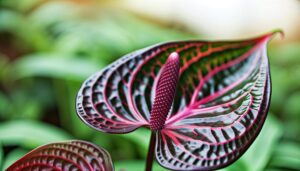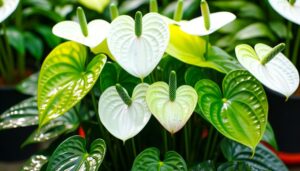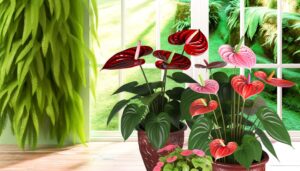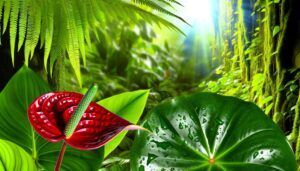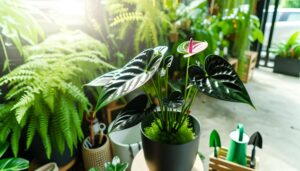Why Is Anthurium Small Talk Pink Unique?
Anthurium Small Talk Pink is unique owing to its carefully cultivated vibrant pink spathes, achieved through precise pigment manipulation and selective breeding. Its compact structure features dense rosettes of glossy leaves, growing to 12-18 inches, ideal for ornamental purposes.
Thriving under bright, indirect light, it requires well-draining soil mixes containing peat, perlite, and orchid bark, and high humidity levels of 70-80%. Regular watering and balanced fertilization are essential for best growth.
Additionally, it is effective in enhancing indoor air quality by filtering toxins. Explore further to understand its propagation techniques and decorative benefits, adding to its uniqueness.
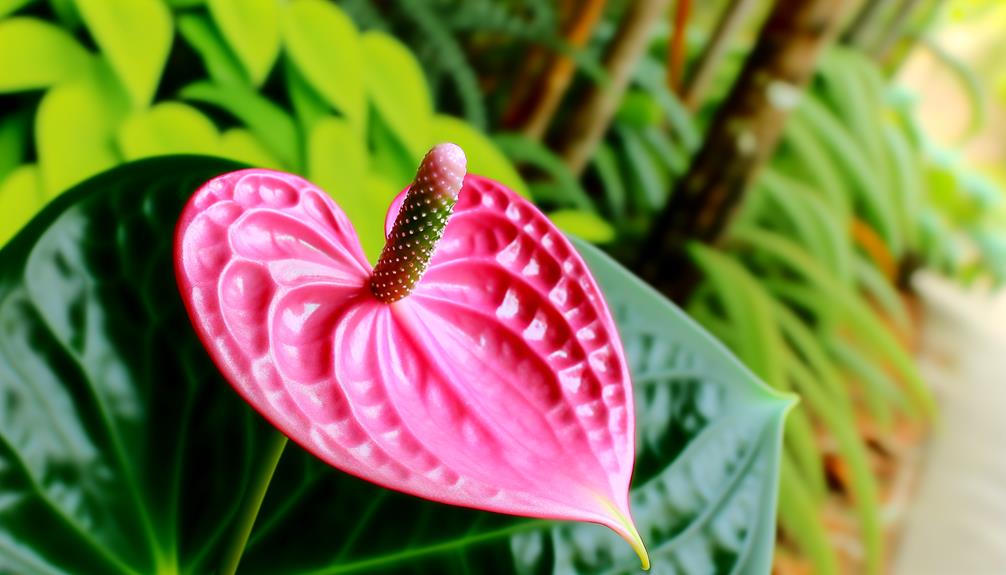
Key Takeaways
- Displays vibrant pink spathes with intricate venation and contrasting spadices.
- Originates from selective breeding focused on ornamental appeal and compact growth.
- Compact size of 12-18 inches makes it ideal for small spaces.
- Thrives under bright, indirect light and enhances pigment concentration with optimal conditions.
- Enhances indoor air quality by filtering airborne toxins and requires low maintenance.
Origins of Anthurium Small Talk Pink
Anthurium Small Talk Pink, a delightful variety of the Anthurium genus, originates from selective breeding practices aimed at enhancing its ornamental appeal and compact growth habit. Botanists meticulously hybridized parent species to achieve this plant's desirable traits, including its reduced stature, making it ideal for interior spaces.
The breeding process focused on developing robust plants with enhanced resistance to common diseases and pests, thereby reducing maintenance requirements. Cultivation involves well-draining, organic-rich soil and maintaining high humidity levels, ideally between 60-80%, to mimic its native tropical environment. Light exposure should be bright but indirect to prevent leaf scorching.
Regular watering, ensuring soil remains moist but not waterlogged, is vital for best growth. Fertilization with balanced, water-soluble nutrients promotes vigorous development.
Unique Pink Hue
What distinguishes the Anthurium Small Talk Pink is its unique pink shade, which arises from the careful manipulation of anthocyanin pigments during the hybridization process. These pigments, responsible for the red, purple, and blue shades in plants, are carefully balanced to achieve the plant's distinct pink coloration.
This precise control over pigment expression is accomplished through selective breeding techniques, maintaining the stability and vibrancy of the hue. Cultivators uphold ideal light exposure and nutrient conditions to enhance pigment concentration, thereby preserving the aesthetic appeal of the Anthurium Small Talk Pink.
Such meticulous attention to detail guarantees that each plant displays the desired chromatic properties, making it a standout choice for ornamental horticulture.
Compact Size and Growth
Beyond its distinctive pink hue, the Anthurium Small Talk Pink is also notable for its compact size, which is a beneficial trait for both indoor and limited-space horticulture. Typically reaching a height of 12-18 inches, this cultivar is ideal for container gardening and small-space arrangements.
Its growth habit is characterized by a dense rosette of glossy, ovate leaves that exhibit a deep green coloration. For best growth, it requires well-draining, organic-rich soil and high humidity levels—conditions that mimic its native tropical habitat. Regular but moderate watering ensures its root system remains moist but not waterlogged.
Moreover, indirect, bright light is essential to maintain its vibrant foliage and encourage consistent development. This compact nature facilitates easy maintenance and versatile placement within interior environments.
Flower Structure and Appearance
The Anthurium Small Talk Pink Unique exhibits a distinctive flower structure characterized by vibrant pink spathes and contrasting spadices.
The spathes display intricate patterns of venation, enhancing their ornamental appeal.
Complementing the floral display, the leaves are heart-shaped with a glossy texture, contributing to the overall aesthetic value of this cultivar.
Petal Coloration and Patterns
Anthurium Small Talk Pink showcases a stunning presentation of petal coloration characterized by its lively pink shades interspersed with delicate, intricate patterns that enhance its decorative appeal. This coloration is mainly credited to anthocyanin pigments and carotenoids, which are responsible for the plant's distinct visual characteristics. The unique patterns are shaped by a combination of genetic factors and environmental influences, such as light brightness and temperature.
To achieve peak coloration, cultivators should consider the following:
- Light Exposure: Sufficient indirect sunlight promotes vibrant pigmentation.
- Temperature Regulation: Maintaining a steady temperature between 65-80°F ensures uniform color development.
- Nutrient Management: Balanced fertilization supports healthy pigment synthesis.
These factors together contribute to the exceptional aesthetic quality of Anthurium Small Talk Pink.
Leaf Shape and Texture
In addition to its vibrant petal coloration, the Anthurium Small Talk Pink features leaves that exhibit a distinctive heart-shaped morphology and a smooth, glossy texture, contributing greatly to its ornamental value.
The leaves are thick and leathery, enhancing their durability and resistance to environmental stressors. Their glossy surface is the result of a waxy cuticle layer, which aids in water retention and reduces transpiration.
These morphological characteristics are not only visually appealing but also play an essential role in the plant's overall health and ease of cultivation.
When cultivating Anthurium Small Talk Pink, it is vital to maintain high humidity levels and indirect light to preserve the leaf integrity and promote vibrant growth.
Light Requirements
Anthurium Small Talk Pink Unique thrives best under bright, indirect light conditions, which mimic its natural understory habitat. Exposure to direct sunlight can lead to photodamage, manifesting as scorched leaves and stunted growth.
For successful cultivation, positioning the plant near east or north-facing windows, or using sheer curtains, guarantees an adequate light environment that promotes healthy development.
Ideal Light Conditions
Proper light conditions are essential for the best growth and vibrant coloration of Anthurium Small Talk Pink. This species thrives under specific lighting requirements that mimic its natural habitat.
Best light conditions can be categorized as follows:
- Indirect Light: Anthurium Small Talk Pink flourishes in bright, indirect light. Positioning near a north or east-facing window guarantees sufficient illumination without the risk of leaf burn.
- Artificial Light: In environments lacking natural light, full-spectrum fluorescent lights are recommended. These should be placed 12-18 inches above the plant and operate for 12-14 hours daily.
- Light Intensity: Using a light meter, aim for a range of 1,000 to 2,000 foot-candles. This range closely replicates the dappled sunlight found in tropical undergrowth, promoting robust growth and striking pigmentation.
Avoid Direct Sunlight
Direct sunlight can cause significant harm to Anthurium Small Talk Pink, leading to scorched leaves and stunted growth. This tropical plant thrives under indirect light conditions, mimicking its native understory habitat.
Optimal cultivation involves placing the Anthurium in a location where it receives filtered sunlight or bright, diffused light. Direct exposure to ultraviolet rays can disrupt photosynthesis, leading to chlorophyll degradation and cellular damage. Utilizing sheer curtains or positioning the plant in east-facing windows can effectively moderate light intensity.
Additionally, artificial grow lights calibrated to provide a balanced light spectrum can substitute for natural light in low-light environments. Ensuring appropriate light conditions is crucial for the Anthurium's vibrant coloration and robust development.
Watering Needs
Maintaining ideal hydration for Anthurium Small Talk Pink involves making sure that the soil remains consistently moist but not waterlogged, as excessive moisture can lead to root rot.
To achieve best watering conditions, consider the following:
- Frequency: Water the plant when the top inch of soil feels dry to the touch. This usually means watering once every 1-2 weeks, depending on environmental conditions.
- Water Quality: Use distilled or rainwater, as tap water often contains salts and chemicals harmful to the plant's health.
- Drainage: Ensure the pot has sufficient drainage holes to prevent water accumulation, which can suffocate roots and promote fungal growth.
Following these guidelines will help maintain the plant's health and vibrant appearance.
Soil Preferences
Selecting a well-ventilated, peat-based potting mix with added perlite or orchid bark is essential for the ideal growth of Anthurium Small Talk Pink. These components guarantee optimal aeration and drainage, preventing root rot and promoting healthy root development. The incorporation of perlite or orchid bark improves the soil structure, facilitating the exchange of gases and retention of essential nutrients. Below is a detailed comparison of common soil additives for Anthurium cultivation:
| Component | Function | Benefits |
|---|---|---|
| Peat | Retains moisture | Provides steady pH levels |
| Perlite | Enhances aeration | Prevents soil compaction |
| Orchid Bark | Improves drainage | Boosts root health |
| Vermiculite | Assists in moisture retention | Boosts nutrient holding |
| Coconut Coir | Enhances water retention | Sustainable alternative |
Thoughtful consideration of soil composition is key in supporting the specific growth requirements of Anthurium Small Talk Pink.
Temperature and Humidity
Peak growth of Anthurium Small Talk Pink necessitates maintaining a temperature range between 65°F and 80°F, coupled with high humidity levels around 70-80%. These conditions mimic the plant's native tropical environment, ensuring optimum physiological processes.
To achieve these parameters:
- Temperature Control: Utilize thermostats to maintain consistent warmth. Avoid temperature fluctuations to prevent stress.
- Humidity Enhancement: Employ humidifiers or place the plant on a humidity tray. Regular misting also aids in sustaining requisite humidity levels.
- Monitoring Systems: Implement hygrometers and thermometers to continually assess ambient conditions, ensuring they remain within the ideal range.
These practices foster robust growth and vibrant coloration, distinguishing Anthurium Small Talk Pink from less meticulously cultivated specimens.
Common Pests and Diseases
In cultivating Anthurium Small Talk Pink Unique, particular attention must be given to identifying common pests such as aphids, spider mites, and mealybugs, which can have a big impact on plant health. Implementing integrated pest management techniques, including regular inspection and the use of insecticidal soap, is important for maintaining ideal growth conditions.
Additionally, disease prevention can be achieved through proper watering practices, ensuring sufficient air circulation, and using clean tools to reduce the risk of fungal and bacterial infections.
Identifying Common Pests
Anthurium Small Talk Pink is susceptible to a variety of common pests, including spider mites, aphids, and mealybugs, which can greatly impact its health and growth. Identifying these pests is pivotal for effective management:
- Spider Mites: These arachnids produce fine webbing on the undersides of leaves, causing stippling and discoloration. High humidity and regular inspection help mitigate infestations.
- Aphids: Small, soft-bodied insects that cluster on new growth, excreting honeydew that promotes sooty mold. Use insecticidal soap for control.
- Mealybugs: White, cotton-like masses found at leaf nodes, sucking plant sap and weakening the plant. Alcohol-soaked cotton swabs can be used for removal.
Regular monitoring and early intervention are essential to maintaining the plant's vigor and ornamental value.
Disease Prevention Tips
Implementing proactive disease prevention measures is essential for maintaining the health and aesthetic appeal of Anthurium Small Talk Pink. This includes reducing the risk of both common pests and pathogens.
Regularly inspect the foliage for signs of aphids, mealybugs, and spider mites. Utilize insecticidal soap or neem oil as a first-line defense. Ensuring proper air circulation and avoiding overwatering can mitigate fungal infections such as root rot and leaf blight.
Employ well-draining soil and maintain a consistent watering schedule to prevent waterlogging. Sterilize pruning tools to prevent bacterial contamination. In addition, quarantine new plants before integrating them into your collection to avoid introducing pathogens.
These strategies collectively enhance the resilience and longevity of Anthurium Small Talk Pink.
Propagation Techniques
To propagate Anthurium Small Talk Pink, one can employ techniques such as stem cuttings, division, and seed germination. Each method requires careful attention to environmental conditions and handling methods.
- Stem Cuttings: Select a healthy stem with at least one node. Cut below the node and place it in a well-draining medium. Maintain high humidity and indirect light.
- Division: Gently separate a mature plant into smaller sections, ensuring each section has roots. Replant immediately in a suitable substrate.
- Seed Germination: Harvest ripe seeds and sow them in a sterile, moist medium. Maintain temperatures of 25-30°C and provide consistent moisture.
These methods, when executed with precision, guarantee successful propagation and robust growth of Anthurium Small Talk Pink.
Decorative Uses and Benefits
Many plant enthusiasts appreciate the vibrant pink spathes and lush green foliage of Anthurium Small Talk Pink as a charming addition to both indoor and outdoor decorative displays.
The plant's striking colors and compact growth habit make it perfect for use as a focal point or accent in various environments. Its long-lasting blooms, which endure for weeks, provide lasting visual interest.
Cultivation in well-draining, organically rich soil and bright, indirect light ensures optimal development and vivid coloration. Additionally, Anthurium Small Talk Pink enhances indoor air quality by filtering airborne toxins.
Its low-maintenance needs and resilience to common pests further increase its appeal for both beginner and seasoned horticulturists. Consequently, this plant is highly prized in both residential and commercial areas.
Conclusion
The Anthurium Small Talk Pink is a botanical gem that symbolizes nature's artistry through its distinctive pink hue and compact form. This cultivar thrives under specific light, temperature, and humidity conditions, embodying the delicate balance needed for best growth.
Its intricate flower structure and resilience against common pests and diseases further underscore its horticultural significance. Propagation techniques guarantee its continuity, while its decorative appeal enhances interior spaces, reflecting the harmonious interplay between nature and human environments.

